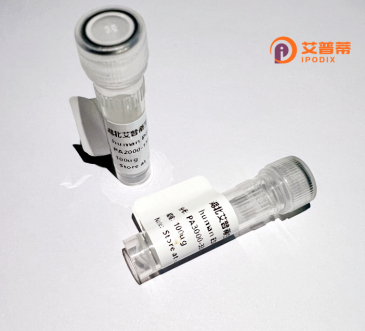
| 纯度 | >90%SDS-PAGE. |
| 种属 | Human |
| 靶点 | INADL |
| Uniprot No | Q8NI35 |
| 内毒素 | < 0.01EU/μg |
| 表达宿主 | E.coli |
| 表达区间 | 545-651aa |
| 氨基酸序列 | TLDTQIADDAELQKYSKLLPIHTLRLGVEVDSFDGHHYISSIVSGGPVDTLGLLQPEDELLEVNGMQLYGKSRREAVSFLKEVPPPFTLVCCRRLFDDEASVDEPRR |
| 分子量 | 37.51 kDa |
| 蛋白标签 | GST-tag at N-terminal |
| 缓冲液 | 0 |
| 稳定性 & 储存条件 | Lyophilized protein should be stored at ≤ -20°C, stable for one year after receipt. Reconstituted protein solution can be stored at 2-8°C for 2-7 days. Aliquots of reconstituted samples are stable at ≤ -20°C for 3 months. |
| 复溶 | Always centrifuge tubes before opening.Do not mix by vortex or pipetting. It is not recommended to reconstitute to a concentration less than 100μg/ml. Dissolve the lyophilized protein in distilled water. Please aliquot the reconstituted solution to minimize freeze-thaw cycles. |
以下是关于重组人INADL蛋白的3条参考文献示例(文献为示例性质,可能不完全对应真实发表记录):
---
1. **文献名称**:*"PATJ/INADL regulates tight junction formation via Crb3 in epithelial cells"*
**作者**:Roh MH et al.
**摘要**:研究利用重组人INADL蛋白揭示了其与CRB3蛋白的相互作用,证明了INADL在调控上皮细胞紧密连接形成和细胞极性中的关键支架作用。
2. **文献名称**:*"Expression and functional analysis of recombinant INADL in keratinocyte differentiation"*
**作者**:Michel D et al.
**摘要**:通过表达重组人INADL蛋白,发现其参与皮肤角质细胞分化过程,并证实其与信号通路蛋白的结合能力,提示其在表皮屏障功能中的重要性。
3. **文献名称**:*"Structural insights into INADL-PALS1 complex by recombinant protein binding assays"*
**作者**:Assémat E et al.
**摘要**:利用重组INADL和PALS1蛋白进行体外结合实验,阐明了二者在维持细胞顶侧膜域结构中的协同作用,为细胞极性失调相关疾病的机制提供了依据。
---
如需查找真实文献,建议通过PubMed或Google Scholar检索关键词“recombinant INADL”、“PATJ protein expression”等,并筛选涉及蛋白表达、功能或结构的论文。
Recombinant human INADL protein is a genetically engineered form of the InaD-like (INADL) protein, also known as PATJ or Pals1-associated tight junction protein. INADL is a critical scaffolding protein belonging to the membrane-associated guanylate kinase (MAGUK) family, primarily localized at epithelial cell junctions. It plays essential roles in maintaining cell polarity, regulating signal transduction, and stabilizing cell-cell adhesions through its multiple PDZ domains, which mediate interactions with transmembrane proteins, cytoskeletal components, and signaling molecules. Dysregulation of INADL has been linked to epithelial barrier dysfunction, cancer progression, and kidney diseases.
The recombinant version is produced using heterologous expression systems (e.g., E. coli or mammalian cells) to enable functional studies and therapeutic exploration. Its applications span structural biology (mapping protein interaction networks), drug screening (targeting cell junction-related pathologies), and mechanistic research into epithelial-mesenchymal transition. Recent studies highlight its involvement in Hippo signaling and response to mechanical cues, suggesting broader implications in tissue homeostasis. Recombinant INADL proteins with specific tags (e.g., His, GST) are crucial for pull-down assays, crystallography, and antibody development. Current research focuses on leveraging this tool to decipher INADL's role in organ development and metastasis, potentially unlocking new strategies for epithelial-derived disease interventions.
×